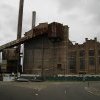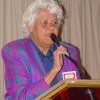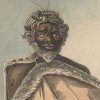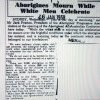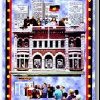1930s
1930
1931
Koori people from the north are establishing themselves in rental housing around Balmain. People from the west live in Redfern and people from the south coast are tending to live in Matraville and La Perouse. During the Depression, Many homeless and unemployed, including Koori people, live under the arches of the Wentworth Park railway bridge at Blackwattle Bay. ‘Happy Valley’ (also known as ‘Frogs Hollow’, is settled by the homeless or unemployed in the area around Little Bay. A large number of Koori people live amongst everyone else in this huge camp of every ethnicity. They don’t live on La Perouse because some don’t want to, some are refused entry by the manager, and some are not welcome to the reserve community.
1932
Lucy Eatock, a white woman married to a Queensland Murri, joins the Communist Party and the Unemployed Worker's Union and is involved in the struggles to prevent evictions of tenants behind in the rent during the Depression in the 1929-33. On one occasion Lucy is flogged by policemen up and down Glebe Point Road for demonstrating against her Uncle Nobby being tried. Like unemployed Koori people generally, she fights for worker’s rights, unemployed workers and women’s rights, as well as Aboriginal causes. Eatock family history is that while convicted non-Aboriginals on trial usually get 3 months jail for civil disturbance, Nobby gets 18 months. (V37, ‘Growing up in the inner city’)
A number of Koori people are involved in community politics. The most impressive public speaker is Jack Patten Jnr. He has been a child at Cummeragunja, in South-West NSW, but grown up at Salt Pan Creek, Georges River, where he develops good relations with the La Perouse community. At about this time he moves to the inner city and is close to the gathering political action. (see also South East section of the website)
An Irish-Koori street teenage gang operates around Palmerston Ave and Lombard St, Glebe. The area is known as ‘Kelly Country’. The gang’s heroes include Robin Hood and the Wiradjuri resistance warrior, Windradyne. Dennis Foley’s father is raised in 45 Palmerston Ave nearby, and is a member of the gang. Dennis Foley’s Auntie Mary Donovan lives in Leichhardt St and works as a domestic. Many Koori men work on the wharves at Blackwattle Bay.
Roger Syron is born at a time when Aboriginal families are living in many places in the inner-city such as Balmain and Rozelle. Roger’s father, a popular war veteran, is able to drink in any hotel where he is known. Roger’s mother is an English migrant. The family comes from Foster and later Roger lives in Rozelle but is thrown out for rent arrears. (Plater, pp. 100-101) (For more see under Stories, 1978)
1933
1934
1935
Mum Shirl (Shirley Smith) moves to Sydney. She writes, ‘I moved down to Sydney about the time King Edward VIII abdicated;… We all moved down, grandfather and more of the family, and we moved into a place in Caroline Street after awhile. My Grandfather didn’t like Sydney much so he went back up to Cowra, and while he was there he stood up and had his photo taken in the Coronation. However, he missed us and his family, so he came back down to Sydney again and died not very long after. My father who was also living with us at this time stayed on in Sydney and worked at a place we called The CCC, which was some sort of company that travelled builders around. ... We moved to a little place in Amelia Street, Waterloo, but that place is non-existent now, it’s been pulled down’.
1936
1937
Uncle Chicka Madden is born at Tamworth. His father joins the army in 1942 and the family moves to Shepherd St, Chippendale, later to Cornwallis St, Redfern. His first school is Redfern Public School, alternating from time to time with Uralla, where he stays with an auntie. Economic conditions were ‘not much better’ in Sydney. Members of his family work at Shelley’s soft drink factory, as bottle washers. Coupons were given for tea and sugar, so kids get goods wherever they could – for instance, broken biscuits from the Arnotts Biscuit factory in Redfern.
Jimmy Little, (born James Oswald Little on 1 March 1937), is an Aboriginal musician, singer, songwriter and guitarist, whose career spans six decades. He lives in Sydney for most of his professional life. For many years he is the only Aboriginal star in the Australian music scene. (‘The city’s full of opportunities’, see video 32)
1938
The Australian Aborigines League and the Aboriginal Progressive Association hold the Day of Mourning, at the building known as Old Bishops Hall, 150 Elizabeth St, renamed Australia Hall in 1923, later known as the Cypress Helene Building. Here Jack Patten calls for new laws for education and care of Aboriginal people and a new policy that will raise Aboriginal people to full citizen status and equality within the Australian community. The meeting attracts 100 people. A permanent conservation order is placed on the building in 1995.
Brenda Palma talks about this, see Barani website, http://www.cityofsydney.nsw.gov.au/barani/main.html
The broadsheet Australian Abo Call is established with Jack Patten as chief editor. It is an important vehicle for distributing news of Aboriginal issues, all over Australia . It's six editions open up issues of ‘Full citizens rights,’ and discuss conflict over school segregation, pressure on reserve lands, the refusal to allow Aboriginal people to control their own family endowment payments, and the denial of access to alcohol. (Goodall, 1996, pp. 240-242)
1939
Mum Shirl estimates 600-700 Aboriginal people living in the inner suburbs of Sydney. ‘We all knew each other and we had little to do with white people, except that we shopped at their shops, and always had to go to them for jobs and work, but mostly we seemed to be with each other.’ (Sykes pp. 25-26)
When the 2nd World War is declared, Mum Shirl’s Uncle David Perry enlists. He serves throughout the war and receives a citation as a 'Tobruk Rat'.











